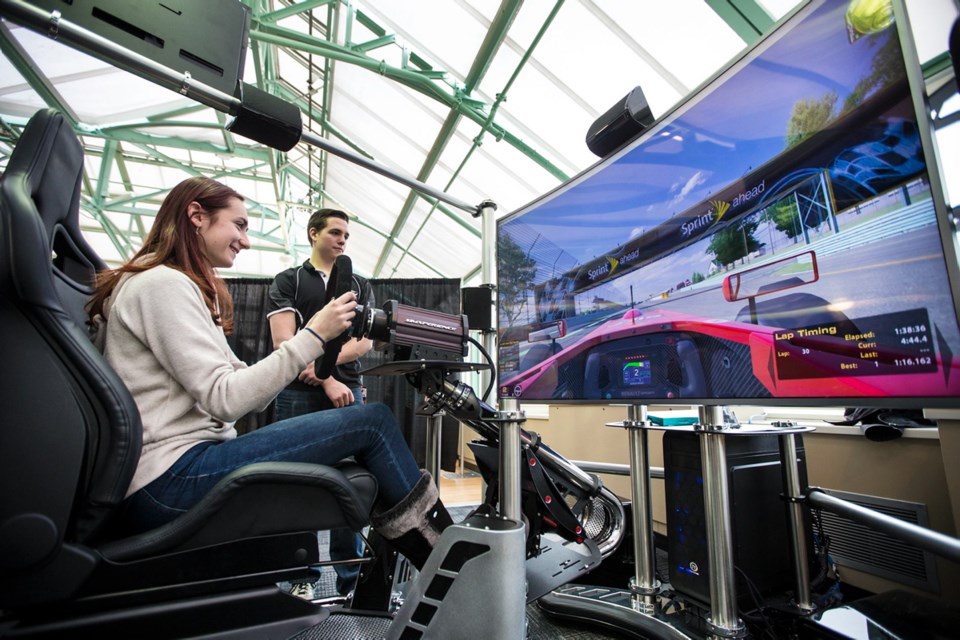There were robots and rockets and a talking glove, oh my!
It wasn’t just super-cool technological crowd-pleasers like these that made Discover Tectoria, the high-tech showcase that packed them into Crystal Garden on Friday, such a blast.
As one visitor remarked, almost as impressive as the high-tech doodads was that there were so many We’re Hiring signs displayed by dozens of local technology companies that participated.
While this family-friendly event did to some extent have the feel of a hiring fair, it was a predominantly educational and entertaining showcase for the region’s thriving tech sector.
“What is Tectoria, anyway?” was one question overheard from those not already in the know about the catchy moniker created by VIATEC (Victoria Innovation, Advanced Technology and Entrepreneurship Council) in 2011.
To quote its playful slogan, Tectoria, the umbrella title for the capital region’s tech sector, is “home to 100 killer whales and 1,500 killer apps.”
To describe the products and opportunites on view as mind-blowing would be putting it mildly, whether you were marvelling over the fun and games or the scientific applications.
Popular draws included Victoria Hand Project’s low-cost 3D-printed prostheses, used in developing countries where amputees have limited access to prosthetic care.
Another eye-catcher was Tango, the revolutionary glove designed to overcome the communications barrier between deaf and hearing individuals by using a glove equipped with sensors and a microcontroller.
A user’s hand gestures correspond to phrases or letters that, via Bluetooth, appear on a smartphone screen in a text format that can be output as a digitized voice.
Kamel Hamdan, Alaa Dawod and Abdul-Rahman Saleh head the development team for the University of Victoria project, working in association with Coast Capital Savings’ Innovation Centre.
Other highlights included LimbicMedia’s interactive blinking-light installation; VRX Ventures’ massive racing simulator; and the Holografx station’s Instagram photo booth.
“We’re creating a new prototype, our biggest screen at 49 inches,” said Anamaria Medina, a Colombia-raised electrical engineer who works at the Esquimalt-based company.
The tech firm develops innovative holographic tools used to showcase products, services and company logos, she said.
“We did the Instagram photo booth because this is what teenagers do now,” she said, pointing to giant hashtags and other social media tools.
Matthew McCormack said he joined a capacity crowd for an afternoon seminar on Victoria’s video game sector in the Innovation Theatre to learn about employment opportunities.
“I want to know how to get into the video game arts. What’s the best route to get my first job, to skip over working at the grocery store and get right to where I want to be working?” the Claremont student said.
McCormack, an avid gamer who plays Rainbow Six, a first-person shooter, and the futuristic vehicular soccer game Rocket League, learned being a fan isn’t necessarily enough.
“It’s a highly competitive industry. We don’t just hire you if you’re really into games,” said Eric Jordan, CEO of Codename Entertainment, with a smile.
“You’ve got to be really good at art, or marketing, or businesss or programming, depending on what we’re hiring you for.”
Jordan offered the crowd some pointers, including Viatec’s Student Video Game Work Experience Program, which gives students a chance to work in a gaming studio.
Moderator James Hursthouse of DigiBC got a few laughs when he asked if “there is something in the water here” to explain why so many tech types come to Victoria.
“I think it’s where people want to live,” said Magda Rajkowski of Kano Apps. “It’s beautiful here, and there’s a lot of creativity.”
Even before you entered Victoria Conference Centre, it was hard to miss UVic Centre for Aerospace Research’s sleek carbon fibre-and-fibreglass drone parked outside.
“This is our workhorse, an aircraft designed to carry payloads, conduct research for companies or collaborators who want to test equipment,” explained operations manager Eldad Alber.
One software developer, for example, asked the team to design wings that would be flexible based on their software designed for such a purpose.
“Hopefully we’ll get more students interested in aerospace,” said Alber. “A master’s program for aeronautics is going to be available soon, so it would be nice to see more exposure and people applying for it.”



